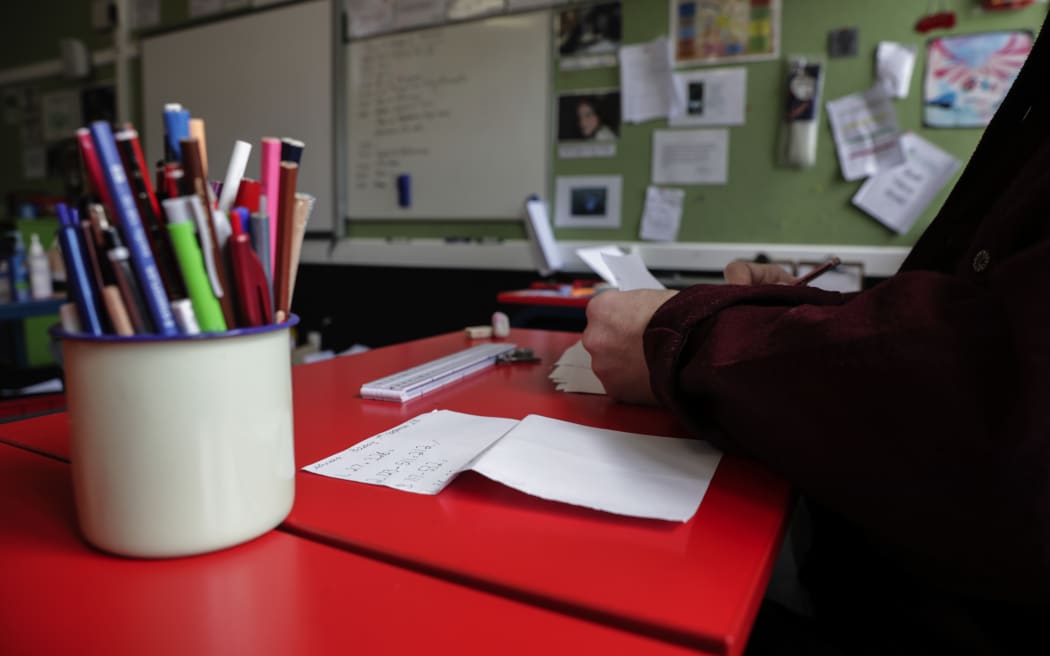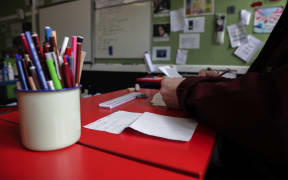
As school rolls drop so too does funding, principals say. Photo: RNZ / Richard Tindiller
Schools in Wellington and Auckland will suffer the biggest losses as the population of school children drops during the next 10 years.
Education Ministry projections provided to RNZ show Canterbury was the only region expected to have more school children by 2032.
The estimates suggest rolls at primary and secondary schools would fall nearly 30,000 or four percent nationally but in the Wellington region they would drop 11 percent, or 8707 children, to reach 71,972 by 2032.
In the same period Gisborne region schools would lose 12 percent of their enrolments or 1088 children while rolls in Nelson, Marlborough and West Coast could be eight or nine percent lower by 2032.
Auckland's schools would have 13,135 fewer children, a decline of five percent.
In Canterbury, school rolls were forecast to rise from last year's figure of 97,564 to 100,092 children by 2026 before dropping slightly to 99,616 by 2032 when they would be two percent higher than in 2022.
Waikato and Taranaki could have one percent fewer pupils.
The figures did not include foreign students or children in hospital or special schools.
"The best knowledge available at the time was used in producing these projections. Uncertainties in live births, external and internal migration, and retention rates would have significant impact on the reliability of these projections," the ministry said.
Increased competition
Wellington Regional Primary Principals Association vice president Nigel Frater said the region's total roll had already fallen by 2000 children since 2021 and his own school had lost one teacher due to a drop in enrolments.
"We're only a seven-teacher school, we've gone to six teachers this year. What will happen though is I'd like to think the numbers will bounce back at our school. We've got a housing development potentially going on locally so I can see that will have an effect," he said.
Frater said he was not confident the decreases forecast by the ministry would continue for 10 years, but further falls were likely to increase competition between schools and stifle valuable collaboration that had developed in recent years.
"You can't be both, you can't be collaborative and competitive. All the models suggest we should be working collaboratively together," he said.
"You're competing because you're funded on the number of students that you have in your school. So if your number's dropping, you want to put things in place to try to bump those numbers back up, so you might increase your spend on marking for example, you might choose to collaborate differently with local schools with, in the back of your mind, your numbers."
Frater said the effect might be biggest on schools in areas where fewer families with children could afford the price of housing.
"Certainly in those more inner-city schools we're going to see potentially the number of teachers that can be employed dropping year-on-year," he said.
Frater said he hoped the ministry would fund smaller class sizes so Wellington schools could keep their teachers.
Clyde Quay School principal Liz Patara said the inner-city school's roll had fallen 13 percent since the start of 2020 due to factors including Covid, lack of immigration and high house prices in the neighbourhood.
"With that 13 percent decrease, we would have lost something like $51,000 in funding so boards have to work really, really hard to find ways of either attracting more students, so in this case attracting more out-of-zone students, or the donations they receive have to increase... in order to provide the same level of education for the reduced number of students."
The ministry's forecast was worrying and she feared the school's diversity would be lost if the roll dropped further, she said.
"The other worrying factor too is who will you lose first. You will probably lose immigration families, Māori and Pasifica because it becomes too expensive to live here," she said.
'Pressure on the network'
Auckland Primary Principals Association president Kyle Brewerton said roll decline in Auckland would vary greatly by location.
Some parts of the region were still "exploding" with population growth, while schools in suburbs with high house prices were likely to experience declining rolls, Brewerton said.
The change could create workforce problems because there might not be enough teachers living in the parts of Auckland that needed them, and there would be fewer jobs overall for teachers in the region, he said.
Canterbury Primary Principals' Association president Sandy Hastings said schools in the region had been growing for years especially in areas such as Lincoln and Rolleston to the south and west of Christchurch.
Most schools were coping well but it could be difficult when growth was bigger than forecast, Hastings said.
"That puts pressure on the network," she said.
"Sometimes the growth is faster than people can predict and sometimes we see that growth is coming and the buildings just can't come quite quick enough."
Hastings said Covid, supply chain problems and rising costs had made it more difficult for schools to get new classrooms in time to match or stay head of rising enrolments.
Regional school roll projections
| Region | 2022 | 2032 | Change (number) | Change (%) |
|---|---|---|---|---|
| Northland | 31485 | 30323 | -1162 | -4% |
| Auckland | 273687 | 260552 | -13135 | -5% |
| Waikato | 83895 | 82899 | -996 | -1% |
| Bay of Plenty | 56159 | 54728 | -1431 | -3% |
| Gisborne | 9327 | 8239 | -1088 | -12% |
| Hawke's Bay | 30424 | 28570 | -1854 | -6% |
| Taranaki | 21638 | 21529 | -109 | -1% |
| Manawatū-Whanganui | 40938 | 39465 | -1473 | -4% |
| Wellington | 80679 | 71972 | -8707 | -11% |
| West Coast | 4489 | 4146 | -343 | -8% |
| Canterbury | 97564 | 99616 | 2052 | 2% |
| Otago | 32981 | 32230 | -751 | -2% |
| Southland | 16629 | 15567 | -1062 | -6% |
| Tasman | 8012 | 7841 | -171 | -2% |
| Nelson | 8500 | 7743 | -757 | -9% |
| Marlborough | 6855 | 6324 | -531 | -8% |
| No region | 7903 | 9644 | 1741 | 22% |
| TOTAL | 811222 | 781440 | -29782 | -4% |






